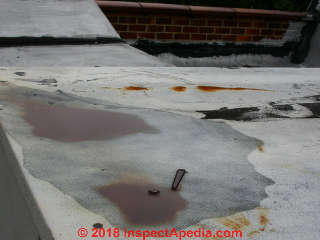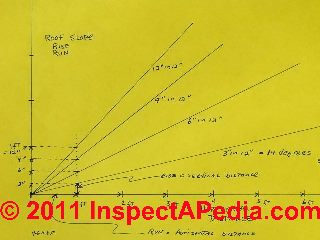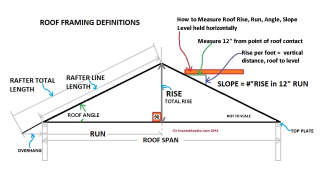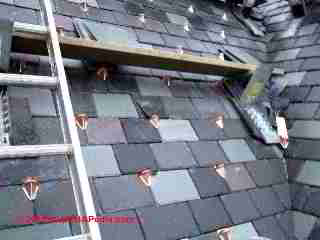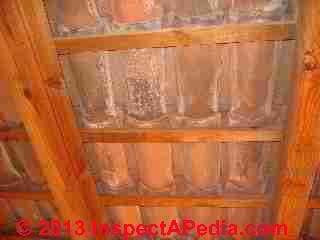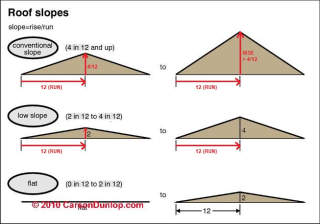 Roof Slope, Rise, Run, Definitions
Roof Slope, Rise, Run, Definitions
How are roof rise, run, area or slope Defined? Roof slope specifications by roofing type.
- POST a QUESTION or COMMENT about types of roofing materials, installation, inspection, diagnosis, repair, maintenance, & warranties
Roof slope definitions & measurement methods:
This article defines different types or degrees of roof slope and explains how roof slope, ptich, angle, or grade slope are measured & expressed. We give the required roof slopes for different types of roofing materials and we illustrate several methods by which the slope or pitch of a roof is easily measured.
We also show how simple measurements can give the roof area without having to walk on the roof surface. We include simple calculations and also examples of using the Tangent function to tell us the roof slope or angle, the rise and run of a roof, the distance under the ridge to the attic floor, and how wide we can build an attic room and still have decent head-room.
This article series gives clear examples just about every possible way to figure out any or all roof dimensions and measurements expressing the roof area, width, length, slope, rise, run, and unit rise in inches per foot.
InspectAPedia tolerates no conflicts of interest. We have no relationship with advertisers, products, or services discussed at this website.
- Daniel Friedman, Publisher/Editor/Author - See WHO ARE WE?
Roof Slope or Roof Pitch Definitions
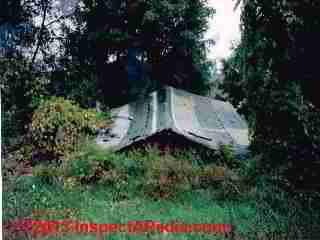 Summary of Definitions of Roof Slope Types: Flat, Low Slope, Steep Slope Roofs
Summary of Definitions of Roof Slope Types: Flat, Low Slope, Steep Slope Roofs
Our photo illustrates a roof whose slope has become irrelevant after the building collapsed. I suspect the roof in the photo was a bit steeper before the building fell in.
[Click to enlarge any image]
The illustration at page top and used again below, courtesy of Carson Dunlop & Associates, summarizes the ranges of roof pitch or slope for flat, low-slope or conventional or "steep slope" roofing.
What is the Difference in Slope Between Low Slope & Flat Slope Roofs?
Actually most flat roofs are not dead flat and in good design also include slope towards their drains.
Flat roofs (0" to 2" in slope) are flatter than low sloped roofs and pitch just enough to drain water.
In our photo below the roof slopes less than 1" per foot - notice the two areas of ponding and staining on this roof.
What is the definition of roof slope and how are rise, run, slope, angle and percent slope related?
Roof pitch or slope is the angle of the roof surface above the "flat" or horizontal plane.
Roofers express roof slope as "rise" or "pitch", measured in inches of vertical rise per foot of horizontal distance or "run". So a 3-inch rise roof, also described as a 3 in 12 roof, means that for every 12" (or foot) of horizontal distance, the height of the roof increases by 3".
Our sketch above shows the relationship between horizontal distance or "run" and roof slope or "rise".
[Click to enlarge any image]
While roof slope is typically expressed in "rise", it can also be expressed in degrees or in percent of slope. A 3-in-12 roof rises 3" for every 12" of run. That's the same as a 14 degree slope, or a 25 % slope. Why is the roof slope 25%? 3" of rise per 12" of run is the same as 1" of rise per 4" of run or 1/4 = 25%.
- Definition of Run: the horizontal change in distance or the horizontal distance covered by an un-supported rafter or truss.
Rafter run: the horizontal or level distance covered by the rafter - the bottom chord or base of a right triangle.
In our sketch above the rafter run is shown as RUN under the left half of the roof. - Definition of Rafter Span: the un-supported length of the rafter along its slope - the diagonal or hypotenuse of a right triangle. In our sketch the "rafter span" is referred to as the RAFTER LINE LENGTH.
- Definition of Roof Span: normally a roof span is the same as the building width between the outer edges of the wall top plates.
- Definition of Rise: the vertical change in height per unit of horizontal distance or run.
Unit rise is a is a snonym for slope or roof slope. For example a 3/12 roof has a unit rise of 3" of height increase or rise per 12" of horizontal run or distance.
Many framers use "rise" and "slope" interchangeably, calling a 3/12 rise roof a 3/12 slope roof. - Definition of Roof Slope: roof slope is the amount of (vertical) change in height as a ratio of horizontal distance traveled, also expressed as inches of rise per foot of horizontal run, or cm of rise per m of horizontal run.
Roof slope can also be described as the angle of change in elevation, expressed in one of several forms
typically in construction we express roof slopes as units of rise per single unit of run, such as 3 inches of rise per 12 inches of run or 3" per ft.- Slope as rise / run, e.g. 3 in 12 or 3/12
- Slope as an angle: e.g. 14 degrees
- Slope expressed as a percent or "grade": Slope is calculated as rise / run or 3 / 12 = .25 x 100 to convert to a percent or 25% grade
Also see ROOF SLOPE TABLE, TYPES, WALKABILITY for a guide to roof slopes versus walk-ability versus roof type and for an explanation of the roof slope ranges that define the catetories of "low slope" and "steep slope" roofs.
Definitions of Low Slope & Steep Slope Roofs
The National Roofing Contractors' Association (NRCA) and other authorities and texts use these general definitions of roof pitch or slope:
Steep slope roofing
is defined as any roof pitched greater than 3 in 12 or 14 degrees or 25%.
Roof slope affects roof life (steeper roofs drain better so may be more leak resistant), as well as roof installation cost (steeper roofs are harder or even impossible to walk-on without using roof jacks or scaffolding, increasing labor costs to install roofing).
Our photo (above-left) shows a steep slope slate roof. You can see by eye that this is certainly more than 3" of rise for every foot of horizontal distance or run of the roof slope, and you'll also see that the slate roofers were using roof jacks to work on the roof surface.
Low slope roofing
is defined as any roof pitched at 3" in 12" or 14 degrees or 25% slope or less. Low slope roofing in other texts refers to roofing systems for pitches below 4" in 12" of slope
See details at LOW SLOPE ROOFING
Flat roofing
is roughly horizontal or "flat" but in fact very few "flat" roofs are really flat, either because it is difficult to build a dead flat surface over a building, or more importantly because even "flat" roofs need to drain water to avoid ponding and leaks.
So most "flat" roofs have at least a little slope either towards one or more roof edges or towards roof drains. So "flat" roofs are really "low-slope" roofs most of the time. To avoid ponding and leaks, flat roofs typically have a nominal drainage slope of 2% to 4%.
Flat roof examples - see MEMBRANE & SINGLE PLY ROOFS
and see FLAT ROOF MOISTURE & CONDENSATION
What are the Minimum Slope Requirement for Metal Roofs?
Most metal roofing systems can be installed on slopes of 3:12 and greater and standing-seam systems from 2:12 and greater.
Special standing-seam systems designed for slopes as shallow as 1/2 :12 require field crimping machinery and have sealant in all seams.
The height of the ribs at seams and whether they are protected with a sealant affect how weathertight a roof will be under extreme weather.
Roof Slope or Pitch Requirements for Clay Tiles
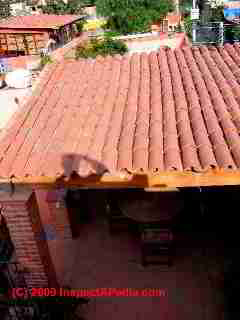
Clay roofing tiles are installed on slopes as low as 4/12, restricted to 6/12 in some jurisdictions. Our photo (above left) shows a low slope clay tile roof in San Miguel de Allende, Mexico.
This roof was built without sufficient pitch (about 2/12) and it leaks badly during heavy rains, as you can see by our photograph of the roof's under-side (above right). Raising the high end of this shed roof a few inches will improve the roof drainage and stop the leak problem.
Where clay tiles are installed on low slope roofs (less than 4/12) for aesthetic reasons, install a waterproof membrane on the roof surface below the tiles.
...
Continue reading at STAIR RISE & RUN CALCULATIONS or select a topic from the closely-related articles below, or see the complete ARTICLE INDEX.
Or see these
Recommended Articles
- 6-8-10 RULE to SQUARE UP ANY STRUCTURE
- ANGLE FINDER LEVEL
- ARCTANGENT CALCULATES ROOF / STAIR ANGLE
- CALCULATE RISE & RUN from SLOPE
- CLAY TILE ROOF SLOPE
- FOLDING RULER ROOF SLOPE CALIBRATION
- FRAMING SQUARE USER'S GUIDE
- FRAMING TRIANGLES & CALCULATIONS
- LOW SLOPE ROOFING
- MODIFIED BITUMEN ROOFING - examples of low-slope roofing designs & materials.
- PRINTABLE PROTRACTOR [Image file]
- RAMP SLOPE or PITCH
- ROLL ROOFING, ASPHALT & SBS - examples of low slope roofing
- ROOF FRAMING TIES & BEAMS
- ROOF MEASUREMENTS
- ROOF SLOPE CALCULATIONS - mathematics of roof slope calculation
- ROOF SLOPE DEFINITIONS
- ROOF SLOPE TABLE, TYPES, WALKABILITY
- STAIR RISE & RUN CALCULATIONS
- TANGENT & SLOPE CALCULATIONS
Suggested citation for this web page
ROOF SLOPE DEFINITIONS at InspectApedia.com - online encyclopedia of building & environmental inspection, testing, diagnosis, repair, & problem prevention advice.
Or see this
INDEX to RELATED ARTICLES: ARTICLE INDEX to BUILDING ROOFING
Or use the SEARCH BOX found below to Ask a Question or Search InspectApedia
Ask a Question or Search InspectApedia
Try the search box just below, or if you prefer, post a question or comment in the Comments box below and we will respond promptly.
Search the InspectApedia website
Note: appearance of your Comment below may be delayed: if your comment contains an image, photograph, web link, or text that looks to the software as if it might be a web link, your posting will appear after it has been approved by a moderator. Apologies for the delay.
Only one image can be added per comment but you can post as many comments, and therefore images, as you like.
You will not receive a notification when a response to your question has been posted.
Please bookmark this page to make it easy for you to check back for our response.
IF above you see "Comment Form is loading comments..." then COMMENT BOX - countable.ca / bawkbox.com IS NOT WORKING.
In any case you are welcome to send an email directly to us at InspectApedia.com at editor@inspectApedia.com
We'll reply to you directly. Please help us help you by noting, in your email, the URL of the InspectApedia page where you wanted to comment.
Citations & References
In addition to any citations in the article above, a full list is available on request.
- NRCA - National Roofing Contractors Association - Website: www.nrca.net 10255 W. Higgins Road, Suite 600, Rosemont, IL 60018-5607, Tel: (847) 299-9070 Fax: (847) 299-1183
- Asphalt Roofing Residential Manual from ARMA the Asphalt Roofing Manufacturers Association Website https://www.asphaltroofing.org/product/residential-asphalt-roofing-manual/ ,
- In addition to citations & references found in this article, see the research citations given at the end of the related articles found at our suggested
CONTINUE READING or RECOMMENDED ARTICLES.
- Carson, Dunlop & Associates Ltd., 120 Carlton Street Suite 407, Toronto ON M5A 4K2. Tel: (416) 964-9415 1-800-268-7070 Email: info@carsondunlop.com. Alan Carson is a past president of ASHI, the American Society of Home Inspectors.
Thanks to Alan Carson and Bob Dunlop, for permission for InspectAPedia to use text excerpts from The HOME REFERENCE BOOK - the Encyclopedia of Homes and to use illustrations from The ILLUSTRATED HOME .
Carson Dunlop Associates provides extensive home inspection education and report writing material. In gratitude we provide links to tsome Carson Dunlop Associates products and services.


